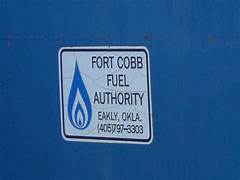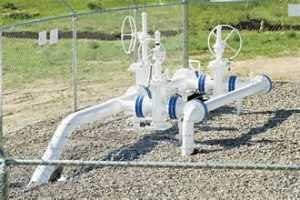
By Mike W. Ray
Southwest Ledger
OKLAHOMA CITY – State regulators examined Fort Cobb Fuel Authority’s natural-gas procurement policies and purchase costs in 2023 and deemed them to be “prudent, fair, just and reasonable” – with a caveat about its line leaks.
Also on Aug. 7 the Corporation Commission established a schedule for a “prudence review” of FCFA’s fuel acquisition processes and expenses for 2024. Direct, “responsive” and rebuttal testimony from the company, the Attorney General’s Office and any other interested parties will be due by Jan. 15, 2026. A hearing on the merits of the case is set for Feb. 12 “and shall continue until the record is closed.”
Andrew Scribner, the commission’s programs manager in the agency’s Public Utility Division (PUD), said these reviews of FCFA’s fuel procurement processes and procedures “ensure the company pays the lowest reasonable cost for gas and accurately passes” those costs through to its customers.
Fort Cobb Fuel Authority, which is based in the tiny northwestern Caddo County town of Eakly, reported it had 3,807 customers in 33 Oklahoma counties in 2023.
That year it purchased 339,004 Mcf (thousand cubic feet) of gas for $2.97 million; FCFA paid an average price of $8.77 per Mcf in 2023, the company reported. The PUD “did not find any errors related to the pass-through of fuel costs to customers” via FCFA’s purchased gas adjustment clause “and verified the PGA factors were accurately applied to customer bills in each rate class.”
In calendar year 2022, when FCFA had 3,864 customers, the company bought 375,161 Mcf and paid $10.04 per Mcf. The comparable price that year for Arkansas Oklahoma Gas was $6.58 per Mcf, and $7.61 per Mcf for both Summit Utilities of Oklahoma (which had about 98,000 customers at that time) and for Oklahoma Natural Gas Co. (which had more than 900,000 customers then), records the companies provided to the Corporation Commission showed.
FCFA buys “a large majority of its supply through discounted bulk supply contracts indexed to first-of-month prices,” Scribner testified. “While this strategy includes some risk of overpaying if spot prices are low in a given month, it also acts as a physical hedge against high prices, which present a much greater risk.”

An example of that was Winter Storm Uri in February 2021. Subfreezing temperatures “curtailed energy production due to equipment outages as well as dramatically increased usage,” wrote Ron Comingdeer, an Oklahoma City attorney for FCFA.
The combination of those effects “precipitated spikes in energy prices throughout the region,” he wrote. “Pricing for natural gas, which began the month at $3 per Mcf” multiplied to more than $300 per Mcf, Comingdeer related.
To provide the “necessary quantities” of gas needed by the company’s utility customers, FCFA “incurred extraordinary costs to maintain gas supply, line pressure and adequate operating conditions on its system.”
The Fort Cobb Fuel Authority absorbed $550,000 in additional natural gas purchase costs in February 2021, Comingdeer told the Corporation Commission. A typical bill for gas buys in February is approximately $200,000 to $250,000, he told Southwest Ledger at the time. The company had to borrow money to be able to pay that extra $550,000, he said.
Gas losses are high
The biggest ding against FCFA is its volume of lost and unaccounted for gas (LUFG).
Thomas Hartline, owner of California-based Navitas Utility Services, Fort Cobb Fuel Authority’s parent company, acknowledged that the company has “a quite high” gas loss of 10%. “Often, for more urban utilities,” typical losses are 2%, “and for major urban metropolitan areas it can be 0.5%,” he said.
“However, this figure may not lend itself to good analysis for small, rural, low-density utilities,” he added.
FCFA has 1,031 miles of pipeline.
When considering the company’s fuel expenses for 2022, an assistant attorney general noted that FCFA’s LUFG percentages have grown in recent years: from 5.22% in 2020 to 8.17% in 2021 and 9.91% in 2022, the Pipeline & Hazardous Materials Safety Administration reported.
Gas leaks on the company’s distribution system, as reported to the U.S. Energy Information Administration (EIA), totaled 78,241 Mcf in 2019; were halved in 2020, to 39,018 Mcf; and fell slightly to 38,201 Mcf in 2021.
Even so, FCFA’s leak losses in 2021 amounted to 37.05 Mcf per mile throughout its 1,031-miles of pipeline, EIA records show.
CenterPoint Energy (whose Oklahoma and Arkansas gas distribution assets were acquired by Summit Utilities in 2022) reported gas losses of 100.13 Mcf per mile along its 2,792-mile distribution system in 2021.
In comparison, ONG recorded 59.47 Mcf in gas losses per mile on its 18,751-mile distribution system in 2021, and Arkansas Oklahoma Gas Corp. reported losses of 3.72 Mcf per mile on its 761-mile system.
West Texas Gas. Inc., which serves 30 cities in Texas and a dozen towns in Oklahoma, including Boise City, Goodwell and Texhoma in the Panhandle, recorded losses of 4.61 Mcf per mile in 2021 on the 1,109 miles of pipeline it has in Oklahoma.
Hartline said Navitas’s Oklahoma system is “essentially two divisions comprised of several smaller subsystems.”
One division is the Fort Cobb Division, whose subsystems include Eakly, Greenfield, Velma, Krebs, Kinta, Dustin, Rimrock; it also serves the WinStar Casino and Resort at Thackerville, Comingdeer confirmed. The other division is the LeAnn Division with its subsystems of Shidler, Mulhall, Dewey, Bowring, South Coffeyville, Lenapah, Peckham, Hill & Dale, Webb City, Pershing, Osage, Nelagoney, Rural Homes, New Harmony and Ochelata.
The Krebs, Kinta and Dustin subsystems “experienced substantial line loss,” Hartline conceded. FCFA “authorized additional overtime hours and other resources to make improvements with the objective of lowering line loss,” he said.
The Rimrock system has “many” leaks “due to the use of PVC pipe when it was installed in the 1970s,” Hartline said. “This reason and the fact that the system serves just over 100 customers, a density of one-half per mile of pipe – compared with urban utilities that exceed 100 customers per mile of pipe – does not make it economically feasible to replace that system.”
Old PVC pipes prone to leaks
In fact, a “very large percentage” of FCFA’s pipeline network was constructed with PVC pipe, Hartline said. Those lines have joints every 40 feet, and each of those joints “has the potential to flex and then leak,” he said. Other sections of the network were constructed from steel pipe, he said. “While most of it is quite sound, a portion, especially in particular older rural communities, are in need of replacement.”
The Jennings, Hallett and Mannford subsystems were excluded from the LUFG analysis because they have “major ownership and supply issues unresolved in bankruptcy proceedings, which forestalled substantial system improvements,” Hartline explained.
Hartline said the company will consider expanding its incentive program “and continue progress on repairing Class 3 leaks in an economically feasible manner.”
Class 3 leaks are recognized as hazardous to people or property at the time of detection “and can be reasonably expected to remain non-hazardous.” The company “reevaluates” those leaks during the next scheduled survey “until the leak is eliminated.”
Class 1 leaks “represent an existing or probable hazard to people or property,” Hartline said. “We immediately commence repair and continuous action until the conditions are no longer hazardous, the source of the leak is eliminated, and permanent repairs have been completed.”
Class 2 leaks are non-hazardous to persons or property at the time of detection “but justify scheduling repair based on probable future hazard.” The company schedules repairs “as soon as economically possible.”
FCFA has 21 field service employees who are “dedicated to leak detection and repair” in Oklahoma, Hartline said.
Gas meters and lines are being replaced
Also, the company’s meter shop tests all meters that are replaced “as part of its preset change-out program,” he said. As of January 2025, all system meters manufactured before 1985 “are disposed of and not rebuilt for redeployment.”
In calendar year 2023, Hartline said, FCFA logged 326 projects. In 68 of them, a total of 4,354 linear feet of pipelines were replaced; seven projects involved replacing 8,512 feet of main lines “along with several service-riser replacements”; and 31 projects involved “the retirement of a main line, risers, or services.”
The Corporation Commission approved Fort Cobb Fuel Authority’s gas procurement policies and natural-gas purchase costs and expenses for calendar year 2023. The regulators also renewed the company’s authorized “safe harbor” provision for lost and unaccounted for gas to remain at a maximum 10%.
The state Attorney General’s Office mentioned “ongoing concerns” regarding the company’s LUFG rate “and the company’s cost of gas,” and encouraged FCFA to “continue to further improve in these areas.”

